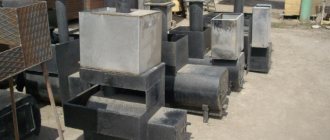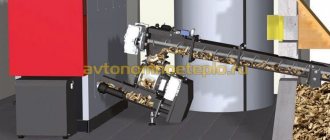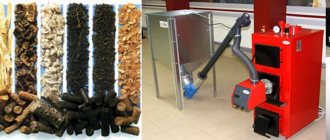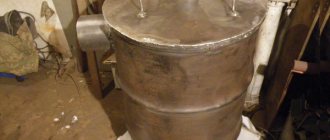How to make a long-burning solid fuel boiler with your own hands: drawings and diagrams
Before you start making a boiler, you need to decide on its design.
Its choice depends on the purpose of the unit. If it is intended for heating a small utility room, garage or country house, then it is not necessary to install a water circuit in it. Heating of such a room will occur directly from the surface of the boiler, through convection of air masses in the room, like from a furnace. For greater efficiency, you can arrange for forced airflow of the unit using a fan. If there is a liquid heating system in the room, it is necessary to provide a circuit device in the boiler in the form of a pipe coil or other similar structure. Connection diagram of a solid fuel boiler to the heating system
The choice of option also depends on the type of solid fuel that will need to be used. For heating with ordinary wood, an increased volume of the firebox is required, and for the use of small fuel pellets, you can arrange a special container from which the granulated fuel is supplied to the boiler automatically. To make a long-burning solid fuel boiler with your own hands, you can take a universal drawing. It is suitable for any type of solid fuel used.
Drawing of a long-burning solid fuel boiler with a power of 25/30/40 kW
We will tell you step by step how and from what parts you can make a long-burning solid fuel heating boiler according to the proposed scheme:
- We will prepare the place where the future unit will be installed. The base on which it will stand must be level, strong, rigid and fire-resistant. A concrete foundation or a thick cast iron or steel slab is best suited for this. The walls also need to be covered with fire-resistant material if they are wooden;
- We collect all the necessary material and tools: of which we need an electric arc welding machine, a grinder and a tape measure. Made of materials: 4 mm sheet steel; 300 - mm steel pipe with 3 mm walls, as well as other pipes of 60 and 100 mm in diameter;
- in order to make a long-burning solid fuel boiler, you need to cut a piece 1 m long from a large 300 mm pipe. You can do it a little less, if necessary;
- We cut out the bottom from a steel sheet according to the diameter of the pipe and weld it, equipping it with channel legs up to 10 cm long;
- The air distributor is made in the form of a circle made of a sheet of steel with a diameter 20 mm smaller than the pipe. An impeller from a corner with a flange size of 50 mm is welded into the lower part of the circle. For this, you can use a channel of a similar size;
- We weld a 60 mm pipe into the middle of the distributor from above, which should be higher than the boiler. In the middle of the distributor disk we cut a hole along the pipe so that there is a through tunnel. It is needed for air supply. A damper is embedded in the upper part of the pipe, which will allow you to adjust the air supply;
Schematic representation of a solid fuel boiler
- in the very bottom part of the boiler we make a small door, equipped with a valve and hinges, leading to the ash pan for easy removal of ash. We cut a hole in the top of the boiler for the chimney and weld a 100 mm pipe into this place. At first it goes at a slight angle to the side and up 40 cm, and then strictly vertically up. The passage of the chimney through the ceiling of the room must be protected according to fire safety rules;
- We complete the construction of a long-burning solid fuel heating boiler by manufacturing the top cover. There should be a hole in its center for the air flow distributor pipe. The fit to the walls of the boiler must be very tight, preventing air from entering.
Drawing with dimensions for creating a solid fuel boiler with your own hands
Useful advice! To ignite a long-burning solid fuel boiler made by yourself, the drawing of which was presented above, you need to: remove the lid and lift the regulator, fill the boiler with fuel to the top and pour flammable liquid over it, put everything in place and throw a burning splinter into the regulator pipe . When the fuel flares up, reduce the air flow to a minimum so that it only begins to smolder. After this, the pyrolysis gas will ignite and the boiler will start.
Converting a stock engine for firewood
To make a car or motorcycle run on wood, you don’t need a lot of money. All it takes is a gasoline engine, hands, tools and some materials.
How and where to place the gas generator depends on the design of the car; some even make it trailed, thereby not disturbing the design of the car. A very interesting option is to use a gas generator on a motorcycle with a sidecar or even alone.
Gas generator theory
Reversed process gas generators are best suited for transport. In generators of this type, air was supplied to the middle part of their height, in which the combustion process took place. The resulting gases were collected below the air supply. The active zone occupied part of the gas generator from the air supply point to the grate, below which there was an ash pan with a gas sampling pipe.
The dry distillation and drying zones were located above the active zone, so fuel moisture and tar could not leave the gas generator bypassing the active zone. Passing through a high-temperature zone, the dry distillation products were subjected to decomposition, as a result of which the amount of tar in the gas leaving the generator was insignificant. As a rule, in reverse gasification process gas generators, hot generator gas was used to heat the fuel in the bunker. Thanks to this, the fuel sedimentation was improved, since the sticking of resin-coated lumps to the walls of the bunker was eliminated and thereby the stability of the generator was increased.
The combustion of carbon fuel can be described as follows:
C + O2 = CO2 is the complete combustion of fuel, which is accompanied by the release of carbon dioxide CO2; and C + (1/2)O2 = CO - this is incomplete combustion, which results in the formation of flammable gas - carbon monoxide CO.
Both of these processes occur in the so-called “combustion zone” of the gas generator. Carbon monoxide CO is also formed when carbon dioxide CO2 passes through a layer of hot fuel: C + CO2 = 2CO. Part of the moisture in the fuel (or moisture supplied from outside) is involved in the process with the formation of carbon dioxide CO2, hydrogen H2, and combustible carbon monoxide CO. C + H2O = CO + H2CO + H2O = CO2 + H2
The zone in which the three reactions described above take place is called the “reduction zone” of the gas generator. Both zones - combustion and reduction - bear the common name “gasification active zone”.
The approximate composition of the gas obtained in the gas generator of the reverse gasification process when working on wood lumps with an absolute humidity of 20% is as follows (in % of volume):
- hydrogen H216,1%;
- carbon dioxide CO2 9,2%;
- carbon monoxide CO 20,9%;
- methane CH42,3%;
- unsaturated hydrocarbons СnHm (without resins) 0,2%;
- oxygen O21,6%;
- nitrogen N249,7%
So, generator gas consists of flammable components (CO, H2, CH4, CnHm) and ballast (CO2, O2, N2, H2O).
All designs are based on:
- reactor
, where the oxidation-reduction reaction takes place, firewood is converted into carbon monoxide and hydrogen; - coarse filter (cyclone)
, removes soot from the gas; - refrigerator
, cools gas; - fine filter,
purifies gas from tar and condensate; - mixer;
- Additionally, fans
for ignition and forced draft to make the startup process simpler.
Reactors come in different types. In order not to write too much, I’ll just post pages and pictures from old books. These are prototypes that were in production. For those who are really interested in building such equipment, this information will be enough to build their own gasgen.
Also on the Internet you can find a lot of already assembled gas generators made from modern materials.
It is not necessary to repeat the design of those years when gas generators were mass-produced; you can take all the materials from the trash heap. Fortunately, such structures have already been built and you can find them on the Internet and watch a video about them.
Motorcycle on wood
One guy converted his Dnieper to firewood - source https://oppozit.ru/article85319.html. Let us briefly describe the remodeling process.
For gasgen it was required:
- barrel 100l;
- steel can;
- disk from a rotary mower;
- a piece of thick-walled pipe with a diameter of about 160 mm;
- receiver;
- pipe with squeegee;
- hexagon;
- stainless steel kettle;
- fire extinguisher;
- battery.
Holes were drilled in the thick-walled pipe for tuyeres to supply air to the combustion zone. We turned tuyeres from a hexagon and welded them to the pipe.
A hole was made in the mower disk for a thick-walled pipe and they were connected by welding. From the cut out part of the disk they made a narrowing of the “active zone” with a diameter of about 80 mm and welded it in the center of the pipe.
We welded the disk with the can.
We cut off a piece from the receiver and made a hole in its end for the outer diameter of the pipe, this will be the air supply to the tuyeres. We welded a piece of pipe with a flue through which air will be supplied. We welded it all to a pipe with a disk. The barrel lid was welded to the can.
They made a grate out of an old stainless steel kettle and hung it on chains for mobility. A nut was welded into the barrel lid and a bolt was screwed into it, which is connected by a cable to the grate and will allow the grate to be shaken for cleaning. You can see this in the video.
A centrifugal cleaner (cyclone) was made from an old fire extinguisher and welded to a barrel without a bottom or lid, and a hole was made in the side for the air supply pipe. At the bottom of the barrel we welded a screw plug through which we will remove the ash.
We inserted the can with the “active zone” into the barrel, clamped the air supply pipe with nuts, and welded the support legs to the disk.
We welded the lid and bottom to the barrel - the gas generator is ready!
A cooler was made from the battery, providing holes for cleaning and draining condensate and connecting flanges.
A fine gas filter was made from two 20-liter paint buckets. The buckets were placed on top of each other, the bottom was filled with expanded clay, and the top with mineral wool. In the lower bucket they made a plug for draining condensate and a pipe with a flange for supplying gas. A drain pipe was made in the upper bucket.
A frame was welded from the corner to mount the gas generator, cooler and filter.
We connected everything on the stroller.
A mixer was made from a pipe and damper from a “Puskachev” carburetor.
An ignition fan was made from the Belarus tractor stove and secured to the front of the stroller.
A distributor was made from two ball valves and squeegees (allows gas to flow to the ignition fan or mixer)
We made an intake manifold for one carburetor from bed frames, placed a mixer in front of the carburetor and connected it with a hose to the distributor. To control the air damper in the mixer, a lever was added to the steering wheel.
How to make a wood-burning gas generator with your own hands
To manufacture a unit with a reverse operating principle, you will need:
- two containers of larger and smaller volume;
- sheet metal for the shaker (movable grates);
- water pipes;
- fan;
- round long tank for cyclone.
Manufacturing step by step:
- Two barrels of about 200 liters in volume are inserted one into the other. There will be a combustion chamber in the inner one.
- A two-inch pipe is welded in to supply combustion air.
- A hatch is installed on top for loading fuel, and in the upper part there is a pipe for removing the finished gas.
- The grate bars are suspended from the bottom of the central container in such a way that they can be moved from the outside, thereby clearing them of slag. And a blower door for cleaning.
- A centrifugal cleaning filter is welded separately from another container or pipe with a diameter of 20-40 cm.
- The cooling radiator is made of two thick pipes (about two inches), connected to each other by thinner ones. The height can reach two meters or more; it is selected individually according to the size and efficiency of the gas generator.
A fine filter is a container filled with:
- expanded clay;
- sawdust;
- metal washers or something similar.
You can use sawdust for fine cleaning only if you are convinced that the gas produced is already quite cold at this stage.
Advantages and disadvantages
To understand the full benefits of a long-burning unit, let’s consider the advantages that the device will bring to its owner:
- High efficiency – up to 95%. This means that the consumption of the generated fuel is justified - the gas burns completely without losing extra calories into the atmosphere.
Experts estimate an efficiency of 60% is already acceptable, which indicates that gas generator units have the best performance.
- Long burning time. This function frees owners from constantly loading fuel, and with automatic settings, from constant monitoring. However, handicraft wood-burning boilers are no different from this and attention is needed. If the owner is clear-headed, setting up automatic security is not so difficult.
- Use of any type of fuel. Only the material used in constructing the unit will depend on it - homemade long-burning wood-burning boilers are made of thick iron, while coal boilers require alloy steel or cast iron.
- The amount of harmful substances entering the atmosphere of the house is minimized due to the tightness of the structure and the rare loading of fuel - the latter is placed in the gas generator boiler only after the previous portion has completely burned out.
The main criterion for owners of private houses to choose a heating unit is obvious cost-effectiveness. Benefits are derived from any garbage that has the ability to burn; firewood may not be needed. Infrequent loading allows you to save on wood fuel, which is required 3-4 times less than for a standard stove. Thanks to stable operation, the heat of the house is maintained at the same level - there is no need to heat frozen rooms and, accordingly, spend a certain amount of raw materials on heating.
Disadvantages: scheme
Unfortunately, gas generation is impossible without forced ventilation, therefore, a wood-burning boiler for heating is considered energy-dependent, since a fan is used. During power surges, it is impossible to leave the boiler unattended, so the problem is solved by connecting an uninterruptible power supply - a device that supplies accumulated electricity.
It is important to maintain a working gas generator on wood in a timely manner in a given mode - a decrease in power leads to the formation of tar that settles on the walls of the chambers, flues and firebox doors . Therefore, when choosing a factory unit or assembling your own design, it is important to take into account the needs and not purchase a boiler that is too powerful for use.
- LiveJournal
- Blogger
Drawing for making it yourself
According to the previous point, the temperature of home heating should not be less than 60⁰C. If this becomes a problem for the owners - a small room, a cottage, intolerance to heat - they should purchase a different solid fuel boiler, and not a wood-burning generator.
Why is it beneficial?
By building a wood gas generator with your own hands, you can count on the following benefits:
Gas generating vehicles
- Reduced fuel consumption. After all, the efficiency of a boiler with a gas generator is 90-95 percent, while that of a solid fuel boiler is only 50-60 percent. That is, to heat the same room, the gas generator will spend no more than 60 percent of the fuel consumed by a conventional solid fuel boiler.
- Long combustion process. Pyrolysis of firewood occurs in 20-25 hours, and the process of thermal decomposition of charcoal ends in 5-8 days. Consequently, loading firewood into the boiler can be done only once a day. And if you use charcoal, then the boiler is “charged” once a week!
- The ability to use any source of cellulose as fuel - from cake and straw to living wood with a moisture content of about 50 percent. That is, you no longer have to worry about the “dryness” of the firewood. Moreover, even meter-long logs can be loaded into the firebox of some models of gas generator boilers, without preliminary grinding (splitting).
- There is no need to clean both the chimney and the vent. Pyrolysis utilizes fuel with virtually no residue, and the product of olefin oxidation is ordinary water vapor.
In addition, it is necessary to note the ability to fully automate the boiler operation process.
The negative side of the practice of using wood-burning gas generators includes the following facts:
- This type of boiler is very expensive. The price of the cheapest version of the “pyrolysis” boiler is two times higher than the cost of its solid fuel counterpart. Therefore, the most zealous owners prefer to build a gas generator using wood with their own hands.
- Such a boiler runs on electricity, which is used to supply energy to systems for blowing air into the combustion chambers. That is, if there is no electricity, there is no heat. But a regular oven will “work” anywhere.
- The boiler generates consistently high power. Moreover, a decrease in heating intensity will provoke a malfunction of the entire system - instead of flammable olefins, ordinary tar will go into the secondary chamber.
But all the shortcomings “pay off” with an abundance of positive characteristics and economical operation of the heating device. Therefore, purchasing a gas generator, and even more so independently building such a “heating device” is a very profitable business. And below in the text we will describe the process of creating a wood-burning gas generator.
Gas generator diagram and operating principle
Carbon is the basis of all biomass on our planet, including wood and various coals, into which compressed plants have turned over millions of years. In heating boilers and internal combustion engines (ICE), we burn hydrocarbons extracted from the depths of the earth: methane, propane and gasoline. They become more expensive every year, forcing home craftsmen to look for new ways using old inventions. One of them is cars with wood-burning gas generators, which appeared at the beginning of the last century.
In the first half of the 20th century, cars and trucks were equipped with wood-burning units.
The essence of the idea is to obtain from wood, through pyrolysis, a gaseous combustible mixture consisting of several carbon-based compounds:
- carbon monoxide (CO);
- free hydrogen (H2);
- well-known methane (CH4);
- other hydrocarbon compounds (general formula - CnHm).
Note. The main flammable component of the mixture is carbon monoxide CO; the proportion of other substances from the list is small. It also contains other gases called ballast - nitrogen, carbon dioxide (CO2) and water vapor. Data on the percentage of substances in the final product and its calorific value are presented in the table:
To release gaseous fuel, a wood-burning pyrolysis gas generator (otherwise known as gasgen) is used, the device of which is shown in the diagram. This is a closed container with grates, filled with solid fuel through the upper hopper, instead of a chimney - a gas mixture outlet pipe. The operating principle of the gasgen is as follows:
- Ignition and combustion of an array of firewood occurs from below, above the grate. A limited amount of air is blown into the chamber through tuyeres (35% of the volume required for complete combustion).
- A large amount of heat is released in the combustion zone and, as a result of the reaction of oxygen with carbon, carbon dioxide CO2 is formed. The content of carbon monoxide and other flammable substances here is low.
- In the reduction (gasification) zone, under the influence of high temperature, carbon dioxide is saturated with carbon from wood and turns into a flammable compound - CO. Here the decomposition of water vapor and the formation of free hydrogen occurs.
- Hot gases passing through the upper layers of fuel dry out the wood and cause it to turn into charcoal (dry distillation), which releases more carbon.
- The gas mixture leaves the gas generator body and is sent for subsequent cleaning to be supplied to the internal combustion engine or boiler.
Functional diagram of a direct process gas generator
For reference. The reduction of carbon dioxide (conversion into CO) occurs with the absorption of heat released during the combustion process. By the way, there are no clear boundaries between the zones and they are shown conditionally in the drawing.
The principle of horizontal gasification - a mixture of combustible gases exits through the side pipe of the generator.
For clarity, we have described the generation of fuel through a direct gasification process, when the fuel mass moves towards the air flow. There are other methods - the reverse process (air is blown from top to bottom) and the horizontal method, shown above in the gas generator diagram. If you want to understand the theoretical aspects in detail, we suggest watching the following video:
Wood-burning model design and diagram
This type of boiler is heated according to exactly the same principle as a conventional solid fuel boiler. Firewood, pellets, briquettes, sawdust and other types of fuel are placed in the lower chamber, set on fire, after which the air damper opens to create draft.
The design of a homemade gas generator boiler is very simple. The basis consists of 2 chambers, closed in one housing. Solid fuel burns in the bottom, wood gas burns in the top. In this case, heated air constantly circulates through the air ducts - warm air rises up and goes outside, cold air is sucked in from the outside, heats up and also comes out. This process continues until the fuel smolders in the chamber.
How to make it yourself
The diagram shown above shows how the boiler functions, where and what chambers are located, so before you begin your own assembly, you need to understand the operating principle of the finished boiler, and also use a drawing of a solid fuel boiler.
In the video you can see how a gas generator boiler works:
- The base of the boiler (body) is any metal barrel; even a used gas cylinder will do. You can make such a cylinder from a sheet of steel 8-10 mm thick, for which you weld it around the circumference and weld the bottom.
- In the upper part of the cylinder, make a chamber with a minimum volume of 0.7 cubic meters, into which solid fuel will be loaded in the future.
- At the very top of the cylinder, weld an additional circle of steel from which cold air will be taken in (skirt).
- To clean wood gas from foreign impurities, coarse rings are used. It is blown through a tuyere.
- To cool the gas, cold air is taken from the skirt. It passes through a zigzag of pipes equipped with several metal rings, gradually cooling.
- If insufficiently dry fuel is used for combustion, condensation will accumulate during boiler operation. It must be drained regularly, for which a similar crane is used.
- The gas generator boiler is the only one in the line of heating equipment that allows you to use even wet – freshly cut – firewood. When in contact with cold air coming from the skirt, too much water is formed, which must be constantly drained. For this purpose, the so-called separator. It is made from a pipe with a diameter of 3-5 mm, into which a plate with ribs is inserted. Passing through the separator, water is removed from the system via a drain tape.
- To increase the power of a gas generator boiler, dry gas is required. To do this, just close the condensate drain valve and open the valve on the gas pipe, which is located immediately behind the separator tube. When gas flows from a small pipe into a large one, it breaks up into gaseous and liquid fractions, after which it passes into the combustion chamber.
- To heat large areas, it is recommended to install a water circuit. You can even make a separate chamber in a gas generator boiler, where water will be heated using the incoming combustible gas. Due to convection, heating occurs at the same time as cooling.
- When piping the boiler, it is recommended to use gas as a source of additional fuel. To do this, just connect the circuit and open the gas supply valve to the additional zone.
Gas generators and heating: main myths
There are many myths circulating about gas generating plants. Basically, we are talking about their effectiveness as part of an autonomous heating system. Let's look at popular sayings that can be found on the Internet.
Myth 1. “The efficiency of a gas generator is much higher than the efficiency of a solid fuel boiler, and reaches 95%.”
Let's start with the fact that these types of equipment are used for various purposes.
:
- a gas generating unit produces flammable gas, and its efficiency is the ratio of the actual product obtained from a certain volume of fuel and the theoretically possible one, multiplied by 100%;
- a heating boiler produces thermal energy, and its efficiency is the ratio of the actual heat produced by burning a certain volume of fuel and the theoretically possible, multiplied by 100%.
Thus, comparing the efficiency of a gas generator and a heating boiler is fundamentally wrong. In addition, the efficiency of a homemade gas generator installation rarely exceeds 80%, so the figures of 90-95% can be considered a myth.
You can compare the efficiency of a pyrolysis and a conventional solid fuel boiler - in this case, the advantage is on the side of the pyrolysis boiler, since the combustion of combustible gases in the secondary combustion chamber significantly increases the efficiency of fuel use.
Myth 2. “The gas generating unit works successfully on raw wood.”
The unit is capable of functioning even when using raw firewood, but its performance drops sharply, since a significant part of the thermal energy is spent on evaporating the moisture contained in the firewood. A decrease in temperature in the combustion chamber leads to a slowdown in pyrolysis and negatively affects the actual power of the installation.
Myth 3. “It is more profitable to use a gas generator for heating a house than a solid fuel boiler.”
The design of a gas generator installation is more complex than that of a solid fuel boiler, including a pyrolysis boiler; in addition, it takes up more space since it includes a cooling circuit. There is no point in installing a more complex and expensive unit in order to burn the resulting flammable gas.
An example of a homemade gas generator installed in the trunk of a car
Thus, a gas generator is made by hand in two cases - for installation on a car and, if necessary, to have on hand a source of energy carrier (combustible gas), the thermal energy of which can be converted into electric current.
Method 2
When creating a gas generator for a car, the main emphasis is not only on the reliability and efficiency of the device, but also on its compactness.
Abroad, the cooling filter, cyclone and housing part are made of stainless steel, which allows the use of metal that is half as thick.
Naturally, this design turns out to be much easier. In our conditions, to reduce the cost of construction, old propane cylinders or fire extinguishers are used.
Liquefied propane cylinders are often used to make external containers.
The internal part is made from the receiver of a truck, for example, KAMAZ or ZIL.
Particular attention should be paid to the grate - it is made of thin metal, and the pipes are made of ordinary pipes (the main thing is to choose the correct diameter)
The upper part of the cylinder is used to make a cover with fasteners. As a last resort, the part can be made of sheet steel.
The lid is sealed using a special cord treated with graphite impregnation and made of heat-resistant asbestos.
To make a coarse filter, you can use an old fire extinguisher or do it even simpler - take a piece of pipe.
At the bottom there should be a cone-shaped nozzle necessary for unloading ash.
At the top, the end must be tightly closed with a lid (as a rule, it is welded).
An outlet pipe is installed in the cover itself, and on the side there is another fitting for supplying combustion products.
The gases released by the gas generator have a high temperature, so they require high-quality cooling.
There are two reasons for this:
- firstly, gases heated to high temperatures have a minimum density, which makes the process of burning them in internal combustion engine cylinders almost impossible;
- secondly, there is a risk of a spontaneous outbreak if the gas comes into contact with hot engine elements.
During the ignition process, it is important to ensure normal gas movement along the path - this work is performed by the fan. After starting the engine, the working composition moves due to vacuum, so there is no need for a fan
After the engine starts, the working composition moves due to vacuum, so there is no need for a fan.
Standard heating radiators can be used as a cooler. The main thing is to position them correctly and ensure maximum contact with air masses.
In some cases, installation of bimetallic radiators is allowed.
Gas fuel must be cleaned before being supplied to the engine - this is ensured using special filters.
We must not forget about another important element - the mixer. With its help, the volume of the supplied gas-air mixture is regulated.
The adjustment is made using the damper.
Types of gas generating plants
Depending on the method of gas combustion, there are several options for gas generators on modern markets. Each of them is good in its own way and is used in different areas. To make it easier for you to make a choice, we suggest familiarizing yourself with each of them.
Types of gas generators:
- A device with a direct generation method burns coal and semi-coke. Here, gas is taken from the top of the unit, and oxygen enters from above.
- Reverse process units burn wood and its waste. Oxygen in such products enters the combustion chamber, and gas is released from below.
- Transverse method devices receive oxygen through tuyeres at the bottom of the housing. From there, only on the other side, gas is released.
Each option has its own advantages and disadvantages. Therefore, they are equally popular. And they are selected depending on the type of fuel and the area of the room.
Nuances of operation and operation of gas generators
It is important to remember that the gas produced by the installation is odorless and poisonous. If mistakes are made when welding the metal parts of the gas generator with your own hands, then trouble cannot be avoided.
For natural air flow in the combustion chamber, you can drill 5 mm holes around the circumference of the housing. All installation work and performance testing should be carried out in a well-ventilated workshop or outdoors.
Lighting a solid fuel gas generator is no different from lighting a wood stove. Firewood or another type of fuel is placed inside, and then they are set on fire with a torch.
After combustion, the damper is closed to limit the flow of oxygen into the combustion chamber. In order for the homemade gas-generating product to work properly, you must correctly adjust the outlet of the resulting gas mixture and the oxygen supply.
Before you start building a gas generator, you should make engineering calculations, in which you need to take into account the combustion area and type of fuel, as well as the required output power and the intended operating mode.
Design features and operating principle
The operating principle of this unit is based on a Peltier element, thanks to which it is possible to generate electricity through temperature. This element has a ceramic coating that acts as an insulator for electricity. One side of the insulator tends to give off heat, and the other, on the contrary, absorbs it. The internal structure consists of 1 copper conductor, and two semiconductors of types P and N.
At the output, this generator produces 12 V voltage. Of course, using a generator with such output is unlikely to be able to provide a number of devices even for household purposes, but by using an inverter or converter, you can get an electric generator that will produce 220V at the output.
The principle of operation of a wood-burning electric generator
In addition to this device, there is another type, this is an automated power plant. This type is more productive; solid fuel is also used as fuel, resulting in electricity.
The operation of the electric generator is quite simple; this requires compliance with all the rules:
- The first thing to do is put fuel in the device and set it on fire. As a result of combustion, the walls of the stove and the Peltier element, which is located on one of the walls, are heated.
- The side located on the radiator will gradually be cooled due to lower outside temperatures. The power of the device will be greater if the temperature difference is greater. The highest performance of the device will be achieved if the temperature increases to 100 degrees.
- Snow or water is used to cool the radiator. Alternatively, you can move the device onto ice.
- It is necessary to remember the maximum temperature values and not exceed these values, otherwise the Peltier element may burn out.
How it works
In order to extract natural gas, it is not necessary to search for a deposit and open a well; you can use a pyrolysis boiler. This is a special type of boiler equipment where fuel burns with minimal access to oxygen, breaking down into wood residue (coal) and combustible gas (propylene and ethylene).
Considering that the combustion of pyrolysis gases occurs simultaneously with the fuel, the efficiency of the boiler increases by 1.5-2 times with the same fuel consumption as a conventional boiler.
Slow combustion of fuel (wood, sawdust, pellets, etc.) provides a much longer combustion process (12 hours compared to 3-4 hours in a normal one).
The diagram shows on what principle the pyrolysis boiler works and how the process of formation of combustible (wood) gas occurs.
Being, in fact, a gas-generating equipment, such a boiler performs a number of tasks, namely:
- Produces low-molecular-weight olefins as a result of the combustion of wood and its constituent cellulose.
- Purifies olefins from all foreign impurities, resulting in a clean combustible gas.
- Cools gases by reducing the amount of energy during final combustion of fuel.
A pyrolysis boiler is always divided into 2 chambers, in one of which the main fuel burns with minimal access to oxygen, the second receives exhaust gases and, when air is pumped in, they are burned.
Such optimization of the combustion process allows us to solve two key problems at once - increasing the efficiency of the boiler and the ability to organize a water heating boiler by connecting it to a water jacket.
The pyrolysis process ensures complete combustion of fuel with maximum heat transfer, which ultimately results in more than 35% cost savings.
It is quite possible to make a gas-fired wood-burning boiler with your own hands, but before that you need to understand the principle of its operation, the design of internal combustion chambers and safety precautions in order to eliminate the slightest violation of technology.
What is an Indigirka stove
This is a bright representative of universal multifunctional stove-generators intended for domestic use. The standard model allows you to generate current with a voltage of about 12 Volts and a power potential of 30 Watts. In this case, the total power can reach 60 watts
Of course, compared to other electric generators, these figures are not impressive, but it is important to consider that in parallel with the generation of current, the Indigirka stove performs a heating function and gives the user the opportunity to cook on the provided burners. As the practice of operating such stoves shows, they can serve several energy-saving lamps, charge batteries of portable equipment, etc.
d. Full use of the stove's resources is possible within 15 minutes after igniting the wood filling in the combustion chamber.
How to make a long burning boiler
Making it with your own hands is not a problem. The design may be different, but the essence is the same - firewood should not burn with a blue flame, but smolder. Any object that resembles a barrel is suitable for constructing a boiler. Although it is possible to weld a cubic furnace using metal sheets and a welding machine powered by AC power. But for this you must have skills in working with electric welding.
So, with our own hands we make a long-burning boiler from a metal pipe that will run on wood. The pipe must have a diameter of at least 300 mm, but its length can be different, which depends on the power of the unit. The longer, the more powerful, and the more firewood can be laid. The power itself depends on the area of the metal surface that transfers heat to the room.
In order for the boiler to take its usual shape, it is necessary to perform a number of actions.
Sequence of operations
Long burning stove
- We cut out three “pancakes” from a metal sheet with a thickness of at least 4 mm - 2 for the bottom and lid of the boiler, and their diameter should match the outer diameter of the pipe, and one for the press with a slightly smaller diameter.
- First of all, we weld the bottom of the boiler. Then we make a rectangular hole on the side for the combustion chamber. A door will be installed at this location. Just below we cut out a small rectangular hole that serves as a blower.
- Now we install a grate between the blower and the combustion chamber window inside the pipe. This can be any grid made of metal reinforcement or wire. The grate can be secured by welding or laid on welded pieces of reinforcement.
- Now from the bottom to the bottom from the outside we weld 3-4 legs from a small diameter pipe, for example, from fifty or forty. Next we move on to making the press. To do this, you will need a prepared small pancake, a pipe with a diameter of 100 mm and several pieces of channel to weight the structure.
- First of all, we cut a through hole in a metal circle, then we weld a pipe to it right in the middle of the pancake. On the other side, we weld the channels - they need to be distributed evenly so that the press presses on the firewood over its entire area. For example, 4 pieces crosswise along the hole. Now we insert the finished press into the boiler from above, and it should go in quietly.
- Then you need to take care of the heat exchanger:
- A tubular heat exchanger can be installed inside the boiler by constructing a small chamber above the press. The pipe will run in the form of a coil along the diameter of the boiler.
- You can install a heat exchanger in the combustion chamber - this is the best option. There is no fire here, and all the thermal energy will go to the coil.
- And the third option is to wind the pipe around the boiler itself from the outside. In this case, you will have to take care of insulation and creating an additional casing made of brick or galvanized steel.
Dimensions of elements of a long-burning furnace
Under the coil, holes must be made on the side of the boiler to connect the latter to the return circuits and supply coolant to the heating system.
- In the second large pancake in the center we make a hole for a 100 mm pipe. This will be the lid of the long-burning boiler. It is usually welded tightly to the body. But the same pipe that is part of the press will come out through the hole. When laying firewood, it will rise behind it, opening the combustion chamber. Fuel loading is best done by two people, where one lifts the press and the other puts firewood into the boiler.
- As for the chimney, the press pipe can be part of it. True, here you will have to redo the chimney itself. It must be dismountable so that during the fuel loading process it can be removed quickly and without problems. And then install it in the same way. If a rectangular design is chosen, the chimney can be free-standing. It is usually welded to the side at the top of the unit.
As you can see, making a long-burning wood-burning boiler from a pipe with your own hands is not so difficult. Instead of a pipe, you can use a metal two-hundred-liter barrel, can and other similar containers. But if you want the device to work for a long time, try to find containers with a wall thickness of at least 4 mm. This thickness will not burn out for a long time despite the high smoldering temperature in the boiler.
Design and manufacture of a gas generator
Let's take a closer look at the device of the gas generator. In addition to the housing, inside which the main part of the elements is located, the design includes
:
- bunker (chamber for loading fuel);
- combustion chamber (this is where the wood smoldering process occurs at high temperatures and with minimal air supply);
- the neck of the combustion chamber (resin cracking occurs here);
- an air distribution box equipped with a check valve;
- tuyeres (calibration holes through which the distribution box communicates with the middle part of the combustion chamber);
- grate (serves as a support for smoldering fuel);
- loading hatches equipped with sealed covers (hatches in the upper part are required for loading fuel, in the lower part - for cleaning the unit from accumulated ash);
- outlet pipe (flammable gas escapes through it and enters the welded gas pipeline pipe);
- air cooler (in the form of a coil);
- filters for purifying gas mixtures from unnecessary impurities.
The gas generator circuit may include a fuel drying system. For pyrolysis to be effective, the firewood must be dry. If part of the gas pipeline runs in a ring around the fuel loading chamber (in the space between the walls of this chamber and the housing), the raw firewood will have time to dry before entering the combustion chamber. This will significantly increase the efficiency of the installation.
The body of the gas generator is made of a metal barrel, on top of which a pipe is attached with corners and bolts to a seal, and a propane cylinder is attached to the inside with bolts
Before making a gas generator, you need to find information about a suitable device model and detailed drawings indicating the dimensions of all elements.
Particular attention is paid to the choice of materials for each of the structural elements. The gas generator can have a rectangular or cylindrical shape - the body is usually welded from sheet metal or a metal barrel is used. The bottom and lid must be made of steel sheet with a thickness of 5 mm.
The hopper, which is bolted inside the housing, should be made of mild steel. The combustion chamber is made of heat-resistant steel; you can use an empty liquefied propane cylinder.
The gas cylinder is installed inside the barrel and bolted to its top
Note! If you are going to cut an empty gas cylinder, first fill it to the top with water - this will eliminate the risk of gas vapor exploding if a spark hits it.
The hopper lid should be equipped with a reliable seal made of heat-resistant material (asbestos cord with graphite lubricant). A fire-resistant insulator (asbestos cord or material with similar properties) is laid between the neck of the combustion chamber and the body. It is more convenient to make the metal grate of the grate removable, from reinforcing bars, to make it more convenient to clean the combustion chamber.
The pipe is attached to the bolts on top of the barrel
An air distribution box with a check valve at the outlet is installed outside the housing; a fan can be mounted in front of it to pump air to increase the efficiency of the unit when working on freshly cut wood.
Blower fan to help improve efficiency
Some craftsmen use a steel or bimetallic radiator as an air cooling coil. The mixer, through which purified flammable gas is mixed with air, is equipped with a fan.
When selecting materials for a permanent installation intended to generate electricity for home use, the emphasis is on reliability and affordability. If you need to make a gas generator for a car, preference should be given to stainless steel - this will make the unit lighter and more compact. But the use of stainless steel significantly increases the cost of the design.
Conclusion
The compact wood-burning gas generator is suitable for installation on a truck or car. The unit for a local power plant can be installed in the basement of a house, in an outbuilding, or, if necessary, installed on the street or under a canopy (when it is necessary to provide electricity to any stationary electrical equipment).
The fundamental issue is the correct operation of the gas generator. In order for the unit to operate with high efficiency, it is necessary to carefully adjust the level of air supply (taking into account the moisture content of the fuel), the intensity of gas removal, etc. It is advisable to manufacture a gas generator according to professional drawings, observing all dimensions and proportions.
Video on the topic:
Operating principle of the equipment
The basis of any power plant is formed by the power filling, which in this case is represented by an internal combustion engine. The energy source is wood fuel, the combustion of which generates electricity. The work process is accompanied by the transmission of torque to the rotor unit. The rotation of the rotor leads to the generation of current, which can subsequently be used in different ways, depending on the demands of consumers and the power potential of the wood-burning station itself. An electric generator, for example, may be equipped with sockets for connecting other equipment or small appliances. Some modifications are combined stove stations, which also provide a heating function using electricity. It should be understood that wood generators are significantly inferior to diesel and even gasoline ones in terms of power, but for domestic needs this choice may be optimal.
Advantages and disadvantages of gas generating plants
The list of advantages of units of this type includes
:
- fairly high efficiency (75-80%) when operating on dry fuel;
- duration of the combustion process (there is no need to constantly add firewood to the firebox; the installation can operate for about a day on one load);
- the fuel burns almost completely, forming a minimum of ash and slag, that is, it is relatively rare to clean the gas duct and ash pan;
- emissions into the atmosphere are minimal, so people who advocate respect for the environment call for the use of wood-burning gas generators instead of gasoline or diesel fuel.
The disadvantages include
:
- energy dependence of the unit, if the design includes an electric fan;
- a reduction in the power of the installation by 50% leads to instability of combustion, due to which tar begins to be released, which pollutes the gas duct;
- buying a ready-made installation is not economically profitable - if you want to save money, you need to install a gas generator that runs on wood yourself from scrap materials.











